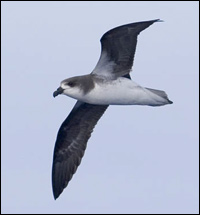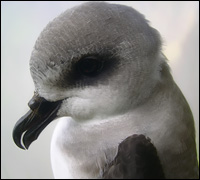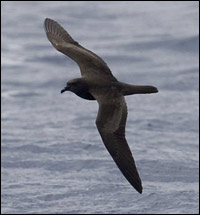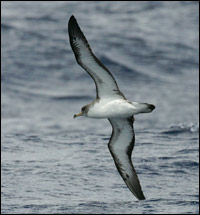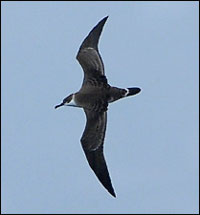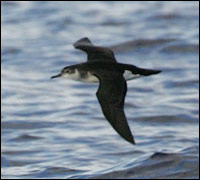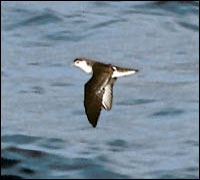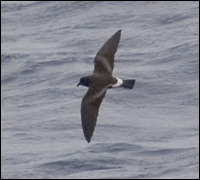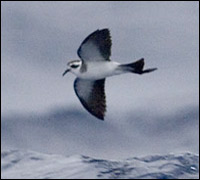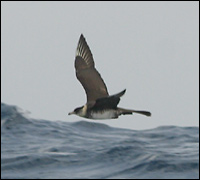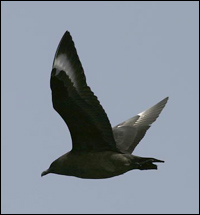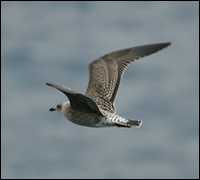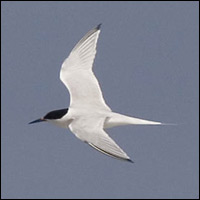|
Fea's Petrel
Pterodroma feae deserta
Resident breeder on Bugio, the southernmost island of the Desertas.
The species use the rabbit burrows on a small plateau for nesting.
The Fea's Petrel breeding season in Bugio is roughly two months
behind schedule in comparison to Zino's Petrel. So laying goes from
mid July to early August and the chicks fledge in December. The
population on Bugio is estimated at 150-200 pairs and the nominate
race which breed on the Cape Verde Islands (500-1.000 pairs). In
the Cape Verde Islands the laying takes place during December and
January. The Fea's Petrel may also breed on the Azores where there
have been several records of birds in potential breeding habitat.
As Fea's and Zino's are very difficult to separate,
if not impossible, a sighted bird in the field often has to be noted
as a Fea's/Zino's Petrel. Nevertheless, you will never be disappointed
when seeing one of these species! Boat trips to Desertas often produce
the best chances to see it at close range, but the numbers always
differ from a few birds to up to 30. With patience you will also
find Fea's/Zino's passing off Ponta da Cruz and certainly at Porto
Moniz. At the latter site they seem to come closer to shore compared
to the former site. During one week of dedicated seawatching you
may see a total of up to 30-40 Fea's/Zino's.
Note:
If anyone may wonder how to distinguish the Fea's and Zino's by
their call I could tell there is no notable differences! In fact,
the Zino's were rediscovered in late 60's when Alec Zino played
up the Fea's call (recorded on Bugio) to Madeiran sheperds all over
the island (The voice of the Freiras = calling nuns)!
Zino's Petrel
Pterodroma madeira
Resident breeder on Madeira. This endemic species is near extinction.
However, during 2003 a new breeding ledge on Madeira was found and
another in 2004 at Pico do Areeiro. The population is now estimated
between 65 and 80 breeding pairs. In April-May they lay their single
egg in self-made nesting holes in several ledges at the peak of
Pico do Areeiro. Soil erosion by feral goats as predation by Black
Rats and feral Cats, are the main danger for the species. However,
a more recent threat comes from Portugal’s proposed construction
of a NATO radar station near the summit of Pico do Areeiro.
The only chance to get a 100% positive identified
Zino's on your list is to visit the known breeding ground at Pico
do Areeiro at night and from there you can hear its spooky calls
when they arrive to their nests. Best time to hear Zino's at this
location seem to be April to mid August. Officially it is forbidden
to use the path between Pico do Areeiro and Achada do Teixeira after
the sunset, which was determined by a governamental resolution signed
in 1999. Therefore it's highly recommend to use one of the guides
available if you intend to visit the area. Don't hesitate to contact
one of the three companies that run nocturnal expeditions to Pico
do Areeiro: Madeira
Aventura, Ventura
do Mar (new from 2006) and Madeira
Wind Birds.
Note:
A few of either Fea's or Zino's can be seen along the Madeiran coast
during the winter. Many birders have reported sightings of Fea's/Zino's
at Porto Moniz between December and February, with up to 8 birds.
For a brief history
of the Zino's Petrel read more here»
Bulwer's
Petrel Bulweria bulwerii
Migrant breeder and only seen between early May (although it is
not until June that large numbers can be seen) and mid September.
The breeding population is estimated at 7.500 pairs. During the
breeding season it could be seen in the whole archipelago. Boat
trips always offer the very best views, because Bulwer's is highly
pelagic and stays far from shore. Highest numbers, although rather
distant, were seen from the southern spot Ponta da Cruz; 2.000 in
the evening on 25 August 2003. At least 3.000 were seen passing
Deserta Grande in the evening on 12 July 2003! In the afternoon
on 31 August 2002 a total of 867 were seen during two hours of counting,
all birds moving to their breeding grounds on the Desertas. At Porto
Moniz the numbers are much lower, but most of them come closer to
shore compared to Ponta da Cruz.
Cory's Shearwater
Calonectris diomedea borealis
A migrant breeder, which breeds from June to October on mainland
Madeira as well on the Desertas and Porto Santo. The breeding population
is estimated to 3.000 pairs (the Salvage Islands excluded). Between
June and October the most numerous breeding seabird to be seen both
from land and boat or ferry trips. Many passing and feeding close
to shore and can offer good views from coastal spots. Could be seen
almost everywhere along the coast. Worthy of mention is 5.700 seen
in the morning of Ponta da Cruz on 6 July 2003 and a incredible
big and loose flock about 1.000 Cory's off Ponta do Rosto on 8 September
2000.
Don't forget to visit Ponta do Garajau (NE of Funchal) to hear the
calls of Cory's Shearwaters when they are visiting their nests when
darkness has fallen (as well the possibility to hear Madeiran Storm-Petrel
and Barn Owl).
Great
Shearwater Puffinus gravis
Migrants pass Madeira in late August to mid September, exclusively
along the north coast and best witnessed from the northwestern tip,
Porto Moniz. Before the year 2000 only a few birds have been reported,
which probably depends on very sporadic seawatching sessions at
Porto Moniz. In 2000 a total of 219 passed on 7 September, which
was an incredible high number at that moment. In the following years
the passage has been even more spectacular: 1.393 on 31 August and
343 on 12 September 2002, 2.932 on 26 August and 4.438 on 7 September
2003. According to the observers in 2003: "We probably missed
1.000's of birds, because there were too many as they passed by
in a seemingly endless stream!"
In year 2004 and 2005 there was no high number
at all counted at Porto Moniz, but in year 2006 there was literally
a all time high peak. Between 24 August and 18 September a total
of 25.284 birds was counted (as we know for certain!) at Porto Moniz,
with four outstanding peak days: 4.472 on 24th August, 5.023 on
1st, 6.600 on 2nd and 3.200 on 11th September!
Remember that the passage of Great, Manx and Sooty
Shearwaters off Porto Moniz is very unpredictable and you have to
spend many days there, in both morning and evening, to hit the right
day. With patience you will certainly be rewarded!
Manx Shearwater
Puffinus puffinus
The breeding population on the Madeira archipelago is estimated
over 500 pairs. Although the species is rarely seen along the coast,
except for the true migrants that pass Porto Moniz between late
August and mid September. High numbers are exclusively seen passing
west off Porto Moniz (late August to mid September), such as: 1.403
on 30 August to 5 September and 2.446 on 11 and 12 September 2002,
1.268 on five days between 3 and 12 September 2003 and 3.081 on
4-9 September 2004. All time high was between 2 and 19 September
2007, when a total of 26.930 birds was logged towards west, of which
10.500 was recorded on 19th. Eighteen birds passing Porto Moniz
on 26 January 2003, which is an interesting record.
Balearic
Shearwater Puffinus mauretanicus
Rare, but regular seen. Especially at Porto Moniz on days with heavy
passage of Manx and Great Shearwater.
Sooty Shearwater
Puffinus griseus
Scarce migrant between late August and mid September. All records
in recent years are from Porto Moniz, though there are no records
before 2000, when 5 passing west on 7 September. Between 30 August
and 12 September 2002 a total of 56 birds were seen as 4 birds between
24 August and 6 September 2003.
All birds occurred on days with heavy passage
of Great and Manx Shearwaters, except a few records during winter.
Little Shearwater
Puffinus assimilis baroli
Resident breeder. The breeding population is estimated over 1.400
pairs, of which 1.000 pairs breed on Salvages, 300 on the Desertas
and several on the small islands off Porto Santo. This species is
recorded in most months of the year, but seem to be more common
in late summer. However, a few observers could tell about high numbers
in April and May off Funchal. Interesting is 33 birds off Porto
Moniz on 25 January 2003. The most reliable site year round seems
to be Porto Moniz and, of course, boat trips to Desertas or Porto
Santo. However the species is not common in any way and even many
hardcore seawatchers that had visited the archipelago did not see
a single bird! Also beware of Manx Shearwaters, which in the strong
light could be mistaken for a Little. The flight action is often
the key to distinguish it from Manx.
Madeiran
Storm-petrel Oceanodroma castro
Resident breeder (one population in the summer and another during
winter), however, many migrate to unknown areas outside the breeding
season. The breeding population is estimated at 2.000 pairs, of
which 1.000 breeds on Salvages. Without any doubt the most difficult
of the breeding seabirds to see, no matter whether you watch from
land or on pelagics. Probably the best way to put the species on
your list is to hear it, when they arrive to their breeding grounds
after the dusk. The best place for doing this is to stay over night
on Deserta Grande, seeing and hearing them arriving to their nest
in the caves located close to the research station where the boat
anchors.
Note: Rarely seen in daylight from land
or boat during the summer. However, the chance to see it from land
or boat seem to be higher in autumn and winter, according to a few
reports and told by many birders. For example: 10-12 single birds
about 3 km off Funchal on 3 January 1996, at least single 15 birds
passing westwards off Porto Moniz on 1 October 1999, 1 from boat
on 31 October 1999 and 3 from ferry crossing on 4 November 1999.
Interesting records from year 2004: In
mid August Chriss Bell and company took the 7pm ferry crossing from
Funchal to Porto Santo as the boat would be approaching Porto Santo
towards dusk (9.30pm at the time). They saw at least 10 Madeiran
Storm-petrels amongst large numbers of Bulwer's Petrels when they
were about 1-2 miles from Porto Santo (sometime around 8.45 to 9pm).
Furthermore, two were seen off Porto Moniz in late August and in
the beginning of September. In addition a few heard calling at Ponta
do Garajau on several occasions.
White-faced
Storm-petrel Pelagodroma marina
About 60.000 pairs breeds on the Salvages Islands, which is located
162 nautical miles (300 km) south of Madeira. Despite this the species
is very rare around Madeira! However, the specie are seen now and
then, for example twice in summer 2004 (close to Funchal on 8th
July and one off Porto Moniz on 19th August) and on three occasions
in summer 2005.
Northern
Gannet Morus bassanus
Scarce migrant in late autumn and winter, especially along the north
coast of Madeira.
Pomarine
Skua Stercorarius pomarinus
Scarce, migrants and wandering birds. In the archipelago this species
appears to be the most regular among the skuas in late summer and
early autumn, especially at Porto Moniz.
Arctic Skua
Stercorarius parasiticus
Scarce, migrants and wandering birds is seen regularly.
Long-tailed
Skua Stercorarius longicaudus
Scarce, migrants and wandering birds and it seems to be the rarest
of the skuas. Worthy of mention is 11 adults towards west off Porto
Moniz on 23 August 2003.
Great Skua
Stercorarius skua
Scarce, migrants and wandering birds. Porto Moniz seems to be the
most reliable site for the few birds that may occur.
Black-headed
Gull Larus ridibundus
Scarce visitor, especially at Funchal harbour and nearby shores.
The numbers vary a lot periodically and many birders leave Madeira
without seeing it. Seem to be fairly regularly during winter.
Ring-billed
Gull Larus delawarensis
Rare but regular visitor in autumn and especially in winter, with
a maximum of three first winter individuals in late January 2001.
Lesser Black-backed
Gull Larus fuscus
If you look carefully through the flocks of Yellow-legged Gulls
you will always find a few Lesser Black-backed. Funchal harbour
and Porto Santo are the most reliable sites to find this species.
The majority of the birds seen in the Madeira archipelago are probably
intermedius/graelsii.
Atlantic
Yellow-legged Gull Larus michahellis atlantis
A resident and common breeder, which is present almost everywhere
along the coast and surprisingly in good numbers on the high plateau
of Paúl de Serra. The most numerous concentration year round
can be found in the harbour of Funchal. This subspecies is found
in the whole Macaronesian region.
Kittiwake
Rissa tridactyla
A scarce passage migrant, especially in late autumn and winter.
An interesting record is of six birds at Porto Moniz in January
2003.
Roseate Tern
Sterna dougalii
A regular breeder, but in low numbers. There is no colonies to be
found in the archipelago, but only single breeding pairs here and
there along the coast of the main island. The harbour of Funchal
seems to be the best place to find this species. Other good sites
where the species has occurred are the bay of Machico, Caniçal,
Ponta da Cruz, São Vicente, Porto Moniz and Calheta. Always
make a practice of looking through flocks of terns carefully!
Common Tern
Sterna hirundo
Migrant breeder and only seen between March and October. Small numbers
could be seen almost everywhere along the coast.
At last, there
are many more seabirds that has occured in the archipelago, but
which are rare or scarce. All those and their status you will soon
find in the new full species list compiled by SPEA (Portuguese Society
for the Study of Birds), which will be published on this web site
later, probably in 2005/2006. In meantime you can use the 'old'
full species list, which is available
here»
Print
version | Back
to main page»
|

